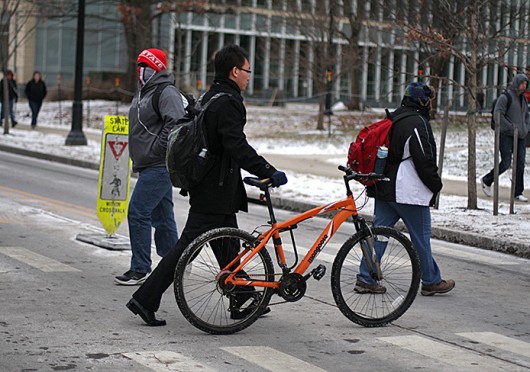
A man walks a bike across 18th Avenue. OSU students living on 4th and Summit streets could soon see designated biking lanes on their roads.
Credit: Shelby Lum / Photo editor
Ohio State students living on 4th and Summit streets could soon see designated biking lanes on their roads. Some students, though, said they’re worried about how safe those lanes will be, and others said they’d rather see bike lanes on campus.
The city of Columbus project to install bike lanes on 4th and Summit streets, which is set to begin in spring 2015, is part of a larger set of projects, called the Weinland Park and Milo Grogan Public Infrastructure Improvement Projects, that are set to cost the city nearly $23 million, according to a Columbus Department of Public Service press release.
Students who ride their bicycles and live in the area said while they’re hopeful for improved safety as a result of the project, they’re not too optimistic.
“It will help with overall biker safety, but it could cause more problems than it might have to,” said Garret Kiger, a fifth-year in mathematics. “Honestly, if we started adding more bike lanes throughout the city it could help, but I’m worried they’ll add the bike lane and it might give a false sense of security to students because drivers aren’t used to having to avoid lanes completely.”
Representatives from the Columbus Department of Public Service did not return multiple calls requesting comment.
The changes to the roads’ designs are not expected to create any problems for OSU Campus Area Bus Service buses, said Administration and Planning spokeswoman Lindsay Komlanc.
“Our CABS bus drivers are currently already trained in terms of navigating a multi-modal transportation system (but) if there are specifics of operations that may need to be adjusted to accommodate the new bike lanes, we will work with the city to understand the implementation and make any needed adjustments from there,” Komlanc said in an email. “We do have sharrows on campus and an extremely active effort to encourage motorists, bicyclists and pedestrians to share the road.”
A sharrow is a shared-lane bicycle marking that includes a bicycle symbol and two white arrows, used to remind drivers that cyclists can use the full lane, Komlanc said.
Some students who live off-campus and bike to class said they’d mostly like to see OSU add more bike lanes to campus.
“Putting bike lanes around campus would be a great thing because of all of the construction making roads congested,” said CJ Sokolick, a fourth-year in human development and family science.
The One Ohio State Framework plan, a long-term planning guide for the physical environment at OSU, calls for the university to make certain changes to campus roads as well, Komlanc said.
“(The plan) calls for making our campus as pedestrian friendly as possible,” Komlanc said. “Especially in the core of campus, so our roadway infrastructure functions a bit differently than the city streets that run in the vicinity of campus.”
Komlanc said bike lanes are likely not going to be a part of that plan, though, because OSU has such a high volume of vehicles needing to share the road.
“It is safer in our case to fully assimilate the bicyclists into the roadway, rather than create an additional conflict point for vehicles and bikes,” she said.
Sokolick, though, said he thinks more needs to be done to keep bicyclists safe.
“Bikers feel unsafe on the road,” he said. “I would like to see a more bike-friendly environment on campus.”


